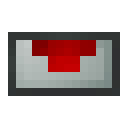Servos

Servos are items that can be installed on itemduct and fluiduct connections. They extract items or fluids from adjacent blocks and insert them into the ducts.
Obtaining
Crafting
Upgrading
| Result(s) | Ingredients | Crafting recipe |
|---|---|---|
| Hardened Servo | Servo + Invar Ingot | |
| Reinforced Servo | Lower tier Servo + Electrum Ingot | |
| Signalum Servo | Lower tier Servo + Signalum Ingot | |
| Resonant Servo | Lower tier Servo + Enderium Ingot |
Usage
Installation
A servo can be installed on an itemduct or fluiduct connection by using it on the connection. It can be removed by using a wrench on it.
Configuration
An installed servo can be configured by using it. The available options depend on whether the servo is installed on an itemduct or on a fluiduct.
A servo’s configuration also affects items or fluids that are inserted into the duct by the connected block.
A servo’s configuration can be saved on a redprint to be copied to other servos, filters or retrievers.
Redstone control
By default, a servo is only active when powered with redstone. However, this is configurable. A servo can be in one of three modes:
- Ignored
- Redstone control is disabled. The servo is always active.
- Low
- The servo is active when not powered. When powered, it becomes inactive.
- High
- The servo is only active when powered. This is the default mode.
Item transfer
When installed on an itemduct connection, an active servo extracts items from the block it is connected to.
Items are extracted from a block in stacks. The maximum size of each stack and the speed at which stacks are extracted depends on the servo’s tier. The maximum stack size can be configured to be lower.
Servos at higher tiers give extracted items a speed boost, causing them to move faster through the itemducts.
Item filtering
A servo can be configured to only extract items that match a given list of items. It has various options that determine how this list is used to match items. Some of these are only available at higher tiers.
- Blacklist/Whitelist
- Treat the list of items as a blacklist (extract all items except these) or as a whitelist (only extract these items). The list is used as a blacklist by default.
- Metadata
- Match items by their exact metadata / damage value. This is used by default.
- NBT
- Match items by their exact NBT data. This is used by default.
- Ore Dictionary
- Match items that are considered equivalent, like the various versions of copper and tin ingots added by different mods. This is ignored by default.
- Mod Owner
- Match items that are added by the same mod. This is ignored by default.
Item routing
At higher tiers, a servo can be configured to prefer sending items to certain blocks in the network.
- Nearest-First
- Items are sent to the connected block that has the shortest path to it first, taking into account dense and vacuum itemducts. This is the default mode.
- Furthest-First
- Items are sent to the connected block that has the longest path to it first, taking into account dense and vacuum itemducts.
- Random
- Each item is sent to a random connected block.
- Round Robin
- Items are sent to each connected block in a repeating order.
Fluid transfer
When installed on a fluiduct connection, an active servo extracts fluids from the block it is connected to. The rate at which fluids are extracted depends on the servo’s tier.
Fluid filtering
A servo can be configured to only extract fluids that match a given list of fluids. The servo has various options that determine how this list is used to match fluids.
- Blacklist/Whitelist
- Treat the list of fluids as a blacklist (extract all fluids except these) or as a whitelist (only extract these fluids). The list is used as a blacklist by default.
- NBT
- Match fluids by their exact NBT data. This is used by default.
Tiers
Servos come in five tiers.
| Tier | Item extraction rate | Max. item stack size | Item speed boost | Item filter options | Extracts from multiple slots | Configurable item routing | Fluid extraction rate | Filter slots |
|---|---|---|---|---|---|---|---|---|
| Basic | 3s | 8 | - | Blacklist/Whitelist | No | No | 50% | 3 |
| Hardened | 2s | 16 | - | Blacklist/Whitelist, Metadata | No | No | 75% | 6 |
| Reinforced | 1s | 32 | - | All | No | Yes | 100% | 9 |
| Signalum | 0.5s | 64 | × 2 | All | Yes | Yes | 150% | 12 |
| Resonant | 0.5s | 64 | × 3 | All | Yes | Yes | 200% | 15 |
Last updated: 2022-08-16 07:03:26 +0000



